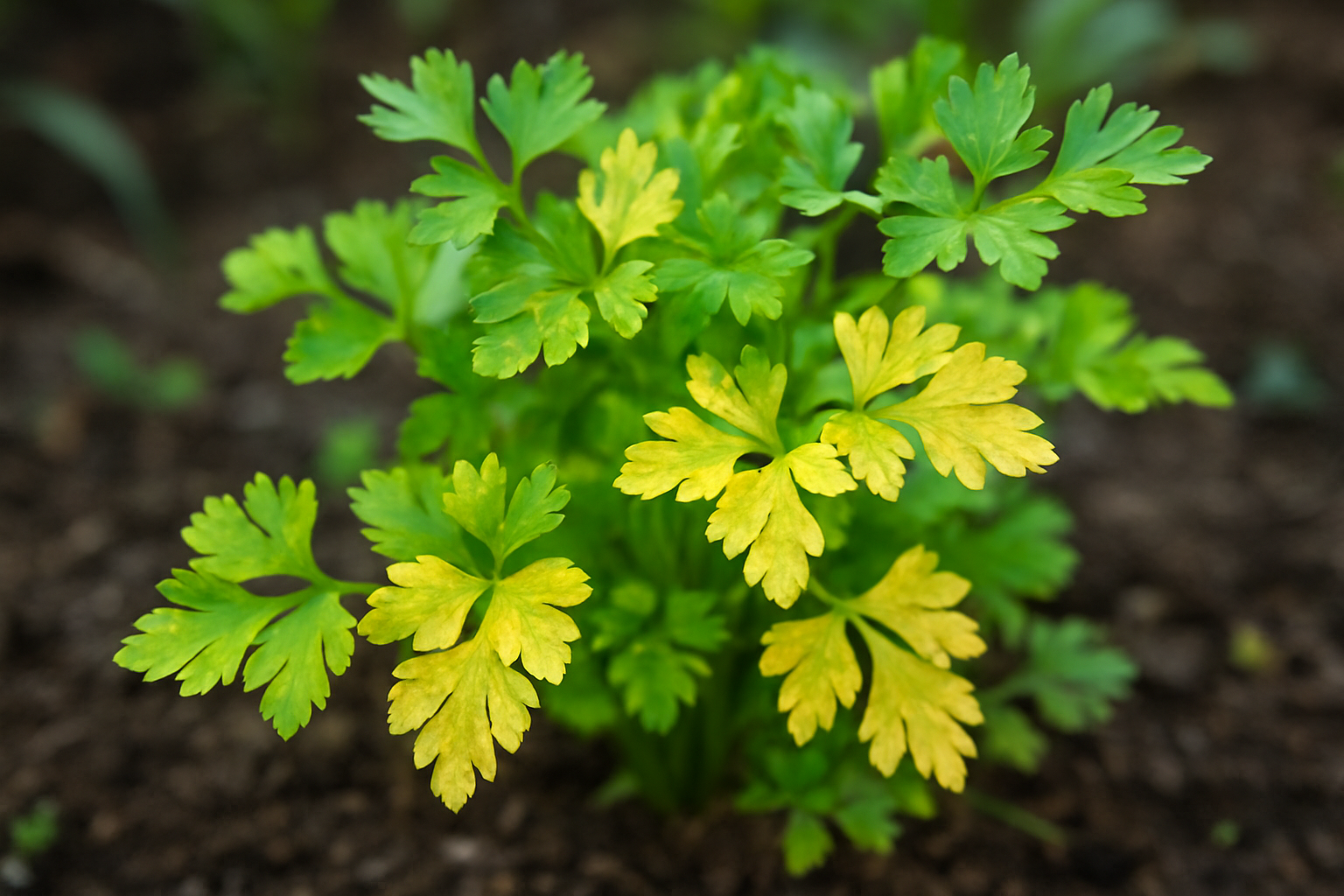If you’ve been growing cilantro and noticed the leaves turning yellow, you’re not alone. Yellowing is a common problem for cilantro gardeners, and the good news is—it usually has a fix. Cilantro turns yellow due to issues like overwatering, nutrient deficiencies, pests, or natural aging. By identifying the cause early, you can bring your plant back to health.
In this guide, you’ll learn exactly why cilantro turns yellow, what it means for your plant, and how to fix it step by step.
Common Reasons for Cilantro Turning Yellow
Cilantro (also called coriander) is a delicate herb that reacts quickly to its environment. If you see cilantro leaves turning yellow, here are the most likely reasons:
1. Overwatering and Poor Drainage
Cilantro is highly sensitive to excess water. When the soil remains soggy for too long, its roots lack oxygen, leading to root rot. This prevents nutrients from reaching the leaves, causing them to slowly turn yellow.
Fix: Water only when the top inch of soil is dry and ensure proper drainage.
2. Underwatering and Dry Soil
On the other hand, dry soil deprives cilantro roots of essential hydration, leading to stress and discoloration. If the leaves look limp and yellowish, it’s often a sign that the plant isn’t receiving enough consistent moisture.
Fix: Keep the soil evenly moist but never waterlogged.
3. Lack of Sunlight
Cilantro thrives in partial to full sunlight, and insufficient exposure weakens photosynthesis. Without adequate light, the plant cannot produce enough energy, leading to pale or yellow leaves.
Fix: Provide at least 4–6 hours of direct or filtered sunlight daily.
4. Nutrient Deficiency
A lack of nitrogen is one of the most common nutrient issues for cilantro. Without sufficient nitrogen, leaves lose their healthy green color and gradually turn yellow. Other missing nutrients like iron or magnesium can worsen the issue.
Fix: Use a balanced, nitrogen-rich fertilizer to restore color.
5. Temperature Stress
Cilantro prefers cooler temperatures and quickly reacts to heat stress. High temperatures can cause bolting (premature flowering) and yellowing leaves, while frost damage in colder areas may also discolor foliage.
Fix: Keep cilantro in a temperature range of 50–80°F for best growth.
6. Pests and Diseases
Aphids, spider mites, and fungal infections like powdery mildew often weaken cilantro plants by draining nutrients or damaging tissue. This stress shows up as yellow, curling, or spotted leaves.
Fix: Inspect regularly and use organic pest control or fungicides when needed.
7. Natural Aging of Leaves
Sometimes, yellowing is simply part of the cilantro plant’s natural life cycle. As older leaves age, they lose chlorophyll, turn yellow, and eventually die off. This is not always a cause for concern.
Fix: Trim off old leaves to encourage fresh, healthy growth.
How to Save Cilantro That’s Turning Yellow
If you’ve noticed your cilantro plant turning yellow, don’t panic. Here’s how to revive it:
Step 1 – Check Watering Habits
- Stick your finger in the soil. If it’s too wet, cut back watering.
- If it’s bone dry, give your plant a deep soak.
Step 2 – Improve Soil and Drainage
- Use well-draining potting mix if growing in containers.
- In garden beds, add compost or sand to loosen heavy soil.
Step 3 – Feed Your Plant
- Apply a nitrogen-rich fertilizer for greener leaves.
- Avoid over-fertilizing, which can burn roots and worsen yellowing.
Step 4 – Manage Pests and Diseases
- Spray neem oil once a week if you notice bugs.
- Remove infected leaves to prevent spreading.
Step 5 – Replant if Necessary
- If your cilantro has fully bolted or is too damaged, let it go to seed.
- Collect seeds for the next season and start fresh plants.
Preventing Cilantro Leaves from Turning Yellow
Healthy cilantro requires consistent care. Here’s how you can avoid the yellowing issue in the future:
- Water Smart: Keep soil moist but not soggy.
- Provide Sunlight: Cilantro likes 4–6 hours of sunlight daily.
- Fertilize Moderately: Use organic compost or liquid fertilizer.
- Harvest Regularly: Cut leaves often to encourage new growth.
- Succession Planting: Sow seeds every 3 weeks for a continuous harvest.
Can You Still Use Cilantro That Turned Yellow?
Yes, but with caution. Yellow cilantro leaves are safe to eat, but they won’t taste as fresh or flavorful as green leaves. They may taste bitter or bland. For the best flavor, use green leaves in cooking and reserve yellow ones for compost.
FAQs
Can I save cilantro when it turns yellow?
Yes, if caught early. Adjust watering, feed with fertilizer, and remove damaged leaves. If the plant has bolted, it’s better to start fresh with new seeds.
Is yellow cilantro safe to eat?
Yes, yellow cilantro is generally safe to eat, but it may not taste as fresh or flavorful as green cilantro. The yellowing usually happens due to age, overwatering, or nutrient deficiency, which affects quality rather than safety. If the cilantro is simply yellow and not slimy, moldy, or giving off a bad odor, it’s safe to use, though it might be better for cooking rather than garnishing.
Final Thoughts
Seeing cilantro leaves turning yellow can be frustrating, especially when you’re hoping for fresh herbs for your kitchen. The good news is that most causes—whether it’s watering, soil, or pests—are fixable. With the right care, your cilantro will bounce back, giving you lush, green leaves for weeks to come.
If your plant has already matured and bolted, don’t be discouraged—just harvest the seeds and plant again for a fresh cycle. Cilantro grows quickly, and with a little attention, you’ll always have a thriving supply at hand.




